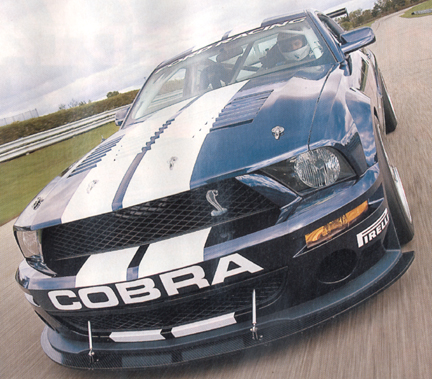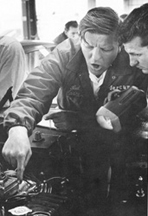Mustang
 |
| FR500GT. |
It’s a throwback, of course. Various styling cues from the original Mustang are included, plus the sound of Steve McQueen’s car from “Bullitt.”
But it’s a modern car, except it also has a fabulous motor, a four-cam, 32-valve, double-overhead-cam V8.
The FR500GT makes a few “improvements” to make it a race-car. The stock motor is levered out and replaced by a Roush-Yates motor, but it’s still four-cam, 32-valve, double-overhead-cam; and fuel-injected too.
NASCAR still uses carburetors, and still uses the pushrod motors — mired in the ‘50s.
The original Mustang was one of the most successful marketing ploys of all time.
The market was obviously ready. The success of the Corvair Monza made the Corvair a Porsche wannabee instead of a Volkswagen wannabee.
And Chevy had introduced the mighty Small-Block in the 1955 model-year; a motor that revved like a Ferrari and turned hot-rodding upside-down. It put the revered flatty out to pasture.
Everything was in place, but Chevy missed the boat.
Ford reconfigured the Falcon platform, and dropped in their own Small-Block, introduced in 1963. Viola; the Mustang.
The earlier Falcon Sprint, a two-door Falcon hardtop with the new motor and four-on-the-floor, was impetus.
But Lee Iacocca saw an opening and developed the new Mustang.
They lengthened the hood and shortened the trunk to give it a sporty appearance (and appearance was what it was all about). Underneath it was still the Falcon — but that was great as the Sprint.
My neighbor Bruce Stewart’s first car was a 1963 Fairlane with 260 four-on-the-floor. He traded it later for a Mustang, but I never saw it (he was out of the house by then).
The Mustang was introduced halfway through 1964; my junior year at Houghton.
As such it was a little beyond-my-time; I was still enamored of the Chevy Small-Block, particularly of the 327 ‘Vette FI four-speed in a 1955 Chevy hardtop.
Yet a couple of Mustangs found their way into our class.
One of “Da Cronies” got one, bought by his father, the coat-hanger magnate. But it was only a six; although three-on-the-floor.
It was far more appealing than The Beast. It was a complete car, and could be driven in rain or snow. I remember going to Buffalo in it; to see a Peter Nero piano-concert at Kleinhans.
Another guy, a mover-and-shaker wannabee, had one. But it was white and automatic: more of a T-bird.
Some of the greatest car-racing I ever saw was between pony-cars. Chevy got on board in 1967: the Camaro. And they began an option to remake the car for racing, option number Z-28.
With the Camaro, pony-car racing turned into a ding-dong battle — Mustang versus Camaro, and later Mopar and AMC.
Chrysler raced their original Barracuda at first, but fielded a team in 1970 of their new Barracudas.
SCCA called the series “Trans-Am.”
In 1969 Ford fielded a racing-option of their own, the Boss 302 Mustang. NASCAR stock-car racer Bud Moore had raced Cougars earlier, and switched to the Boss 302. He hired Parnelli Jones and George Follmer to race his cars.
 |
| Bud Moore pointing. |
Jones and Follmer were on the front-row, and came over that blind brow at 160+ mph; flat out, not giving each-other an inch.
Down that hill they slid, bottoming their suspensions at the bottom. The track-bars on the cars scraped the pavement, and threw up a shower of sparks.
It’s an image I’ll never forget — right up there with Big Daddy at Cecil County. I’ll carry it to my grave.
Those ‘69 Mustangs were fairly ugly, but looked better in 1970; when Ford made a mustard-yellow version available.
Bud Moore painted his cars mustard-yellow, and Parnelli/Follmer raced them.
Mark Donohue won that Bridgehampton race in a Penske Camaro, but switched to AMC-Javelin in 1971. They made that pig into a potential winner — even won a few.
And I remember Jerry Titus drifting his 1967-or-1968 Mustang at Watkins Glen.
After the start was a long uphill esses that emptied onto a long back-straight. Titus would consistently drift through that corner with the car sideways. Titus later killed himself crashing a Trans-Am Pontiac into a bridge-abutment at Road America race-course in Elkhart Lake, Wisconsin.
The Glen didn’t have bridge-abutments, but did have that awful three-high guardrail that could make a royal mess of anyone who rode it. Francois Cevert lost his life in a Formula One Tyrrell when he rode that guardrail. That guardrail was installed to satisfy a safety-concern by drivers.
The Trans-Am drifted into anonymity after GM and Ford pulled out (as did Mopar). Foreign cars were let in, such as the Porsche 911, the Datsun 510, and the Alfa Romeo.
Those early years when Trans-Am was between GM and Ford (and Mopar), was when it was really great. And the cars raced were actual stock-cars — stock-cars modified for racing — not some tube-frame special made up to look like the stock-car with draped-on sheetmetal.
 |
| Follmer and Jones in the mustard-yellow Mustangs. |
Those early Trans-Am cars were hardly driveable on the street either, but at least based on stock-cars.
NASCAR has made the same mistake — tube-frame specials that look like the stock offering, but aren’t even close. Sure, take your Granny to church in one of them things! What if it rains?
So now Ford wants to make racing this FR500GT into a series, a lot like the old Trans-Am. The car is for sale at $225,000, and they have a couple buyers. But it can’t be driven on the street, although it has wipers and headlights.
Hertz has dredged up their old program of renting special Shelby GT-H versions of the Mustang that they had years ago. They had one on display at Orlando; and I would have liked to rent one, but you apparently have to jump through hoops, and they are only two-door.
Linda’s aging mother needed a door; so that scotched the GT-H.
The GT-H was also available at Logan, so if I’d known I could have rented one at Rachel's wedding, but didn’t know. (I can just see it: navigating some condo parking-lot in a GT-H. “Get yourself turned around. We know that guy. He gave you a bum stear. You’re headed toward New England.”)
Plus the all-powerful Tim Belknap at the mighty Mezz, who despite being only a city-editor puts Executive-Editor Bob Matson and Managing-Editor Kevin Frisch on-the-trailer, poo-poos the GT-H as being a mere imitation of the great GT-Hs of yore. A kit-car. It has 325 horsepower.


0 Comments:
Post a Comment
<< Home